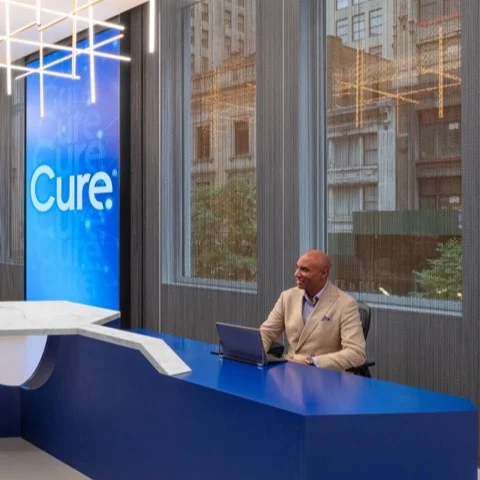Despite decades of research and billions of dollars invested, frontline cancer treatment still relies heavily on the same invasive and toxic tools that have defined the standard care for generations: chemotherapy, surgery and radiation. While newer innovative classes of medicines – immunotherapies, cell and gene therapies – are available, they are often only approved for patients whose cancer has already recurred and not early-stage patients.
How to change this situation and find new therapies was the topic at a 2024 BioFuture panel at Cure’s New York headquarters. Moderated by Jay Campbell, Managing Director at the Cancer Research Institute, the discussion featured experts from across the cancer ecosystem: Irina Babina, PhD, MBA, CEO of Concr; Lynda Chin, MD, Founder and CEO of Apricity Health; Jacob Gottlieb, MD, of Altium Capital Management; and Daina Graybosch, PhD, an analyst specializing in oncology at Leerink.
“The current paradigm is that we wait until the patient fails and becomes refractory from the standard care,” Chin said. “They're on the cliff about fall over, and then you say, ‘Okay, now I can test my next or combination.’ Everything is against you.”
This scenario is no coincidence. Financial pressures drive biotech companies to pursue the fastest path to FDA approval possible, prioritizing therapies for patients who have already failed several prior treatments. Because of this population’s dire situation and lack of effective options, regulatory agencies make it easier and quicker to win approval for new treatments. But this leaves early-stage patients who may also greatly benefit from these less toxic and potentially curative approaches with limited access.
Not helping matters is the investor pullback from the biotech sector in recent years, slowing the flow of capital needed for innovative research. Although such cycles are not uncommon, they can stymie progress for years at a time, creating gaps in potential breakthroughs.
The Tension Between Cancer Data and Clinical Action
Only a small percentage of cancer therapies that enter clinical trials ever make it to patients. Therapies often fail due to poor understanding of real-world cancer biology and limited tools to predict which patients will benefit from treatment.
Even with predictive biomarkers, which can double success probability, the overall rate is less than 10 percent. These figures underscore a glaring inefficiency in the development pipeline, which often fails to connect early research insights with meaningful patient outcomes.
The Preclinical Paradox in Cancer Research
Even before reaching human trials, cancer research faced a fundamental challenge: preclinical work has become increasingly undervalued among investors despite its critical importance. The problem goes beyond funding – researchers can breed mice with a single mutation and demonstrate that their experimental medicine can safely and effectively silence it. But the human immune system is much more complex and harder to predict.
“Our preclinical models, no matter how sophisticated, can’t capture the diversity of the human response,” Chin said. "You can have two identical twins that have completely different immune systems, because they can get exposed to different things in their lifetime, live in different environments, ate different foods – and somehow we think that we can model them in the mouse.”
Wary and Weary Investors in the Cancer Sector
Even if the results of preclinical work were more predictable of real-world success, investors aren’t interested right now, according to Graybosch. During the biotech bull market from 2017 to 2021, financiers were putting money toward promising early developmental efforts, but feel burned after so few of these progressed to commercialization.
“Preclinical work is almost entirely dismissed by public market investors right now, they just don't care,” Graybosch said. “I do think there's probably some lost opportunities.”
Biotech Initial Public Offerings (IPOs) peaked in 2021, when more than 100 companies went public and raised nearly $15 billion, according to Biopharma Dive. But things have stalled since – only 19 companies in the space went public in 2023 and this year, there have been 27 biotech IPOs through November 2024.
“There was a time when you could raise capital based on two promising patients,” Gottlieb said. “Those days are over.”
Cancer Biology is the Problem
Despite these challenges, basic research remained essential. Babina argued that while understanding biology was the ultimate problem, the solution wasn't to abandon preclinical work but to make it smarter through better use of technology and data translation. This included publishing negative results, which rarely happens but could provide valuable insights.
"We don't do that," Babina said. "We can learn this much from negative data as we can positive."
The Cancer Case for Early Detection and Prevention
Panelists highlighted the untapped potential of early detection and prevention, which could shift cancer care away from reactive treatments toward proactive intervention.
Emerging tools like blood-based biomarkers and longitudinal patient data could make this possible, but challenges remain. For example, current detection methods often struggle to distinguish between lesions requiring treatment and those that don’t.
“We need a deeper understanding of cancer biology to make early detection reliable,” Chin said. “Imagine finding patients six months before their cancer progresses.”
Regulatory Nudges to Accelerate Anti-Cancer Therapies
The FDA has recognized the need to funnel innovative experimental treatments towards broader patient populations. To accomplish this, the agency has launched initiatives such as Project Optimus, which focuses on tailoring drug doses to individual patients, and Project Front Runner, which advocates for testing therapies earlier in treatment lines.
“The FDA is making strides, but we’re still stuck in old paradigms,” Babina said. “We have the tools to run smarter experiments, but the system hasn’t fully caught up.”
Toward a Transformational Future in Cancer Treatment
Babina said the industry needs greater collaboration to ensure that promising therapies don’t die on the vine.
“We’re leaving valuable tools on the table because we’re not sharing data or working across silos,” Babina said.
Smarter data collection, better trial designs and a shift toward early detection could dramatically reshape the cancer research landscape. Getting there will depend on systemic reforms that align incentives, accelerate learning and prioritize patients.
“We’re at a tipping point,” Chin said. “If we can rethink how we approach data and collaboration, we have a real chance to change what cancer care looks like in the next decade.”







